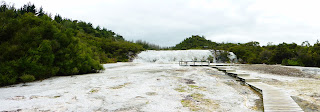On Saturday morning heavy rain showers greeted us for only the second time in our travels. We took this opportunity to visit the Auckland War Memorial Museum. This architecturally stunning building housed displays and artifacts on New Zealand history, natural history and war history. The museum is so extensive that we only covered 2/3's of their exhibits in the four hours we were there.
The full scale Maori (Mow-ree) meeting hall is being restored on site, including the removal of red paint from all of the side columns and ceiling ribs, as well as the re-caning of all the original and replica side wall panels - a three year process.
One of these faces does not belong in the meeting hall ... hmmm?
Leaving the museum to clear blue skies and warm temperatures we strolled the Auckland Domain beside the museum. This parkland is Auckland's oldest, containing all of the explosion crater and most of the tuff ring of the extinct Pukekawa Volcano. Trails to half century old greenhouses, cricket/rugby fields, open green space, gardens, ponds ... were there for us to discover.
Sunday morning's blue skies and summer temperatures made it ideal to hop on the ferry to Devonport, a suburb of Auckland, located on the north shore across the bay. The 15 minute ferry ride is one of a multitude of water taxis connecting the city and the suburbs. Our walk in Devonport took us to the top of North Head, an extinct volcano, providing a wonderful scenic view of the Auckland waterfront. The North Head is the historical site of the 1914 military emplacements that New Zealand used throughout both WW I and II. The original military armaments, bunkers and buildings provided a first-hand look at New Zealanders' role in both of the wars. A picnic lunch overlooking the leisure boat traffic in the bay made for the perfect afternoon.
Beach directly below North Head - a very active kite surfing area.
The city skyline can be seen in the background behind the military base on North Head.


























